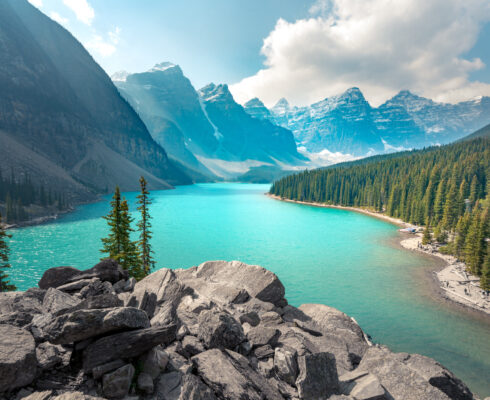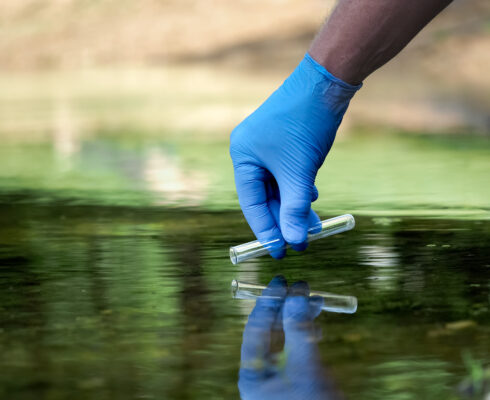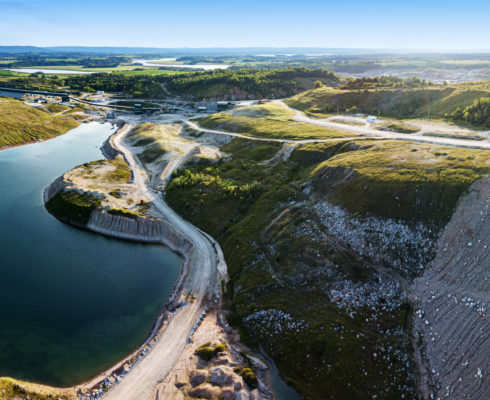 Heather Veilleux, PhD, Environmental Scientist
Heather Veilleux, PhD, Environmental Scientist
“I always envisioned myself looking into a microscope. I was fascinated with observing a world we don't normally see. One of my first school trips was to the Baxter Conservation Area where we got to take samples of a pond and see all the different organisms under the microscope – I was hooked,” she says.
Combining her passions for molecular biology and zoology, Heather completed her Bachelor of Science in biochemistry at the University of Ottawa.
She then moved to Australia for 10 years, where she completed her Master’s degree, PhD, and first Postdoctoral Fellowship in marine molecular biology at James Cook University working on the Great Barrier Reef.
“I was supposed to be in Australia for one-and-a-half years and it turned into a decade.”
It was during her time in Australia that she was first introduced to using DNA in the environment (eDNA) as a biomonitoring tool. eDNA, which can be shed from any organism to soils, sediments, and water, can be collected, isolated, and analyzed so species present can be better identified, monitored, and researched. In Australia, she helped develop assays for invasive sea squirts and crabs, hammerhead sharks, and sawfish.
There are so many practical applications for this technology, and I found that it was much more rewarding to be able to use all my background in molecular biology and ecology to be able to have real world impact on how to conserve species.
In June 2023, the paper for Heather’s first eDNA project was published. It describes how the team developed an eDNA assay to detect the invasive Asian paddle crab, Charybdis japonica. Heather designed the assay, performed the experiments and analyzed the data, prepared figures, authored and reviewed drafts, and approved the final report. As well as already being adopted into the routine sampling regime for biosecurity surveillance in Western Australia, it was the project that set her on an eDNA-focused path.

She found the eDNA work so fascinating that, when she returned home to Canada to undertake a Postdoctoral Fellowship at the University of Alberta, she applied for an Alberta Conservation Association (ACA) grant to develop an eDNA assay for detecting Arctic grayling, a fish species of special conservation concern.
The project was so defining it resulted in a robust assay that is now being implemented by Provincial Wildlife managers and Northern Lights Fly Fishing / Trout Unlimited Canada to improve the species’ detection and protection.
In 2022, Heather was awarded another grant by the ACA for an eDNA project with two main functions. First, to develop an eDNA assay for distinguishing native Athabasca Rainbow Trout from introduced Rainbow Trout. Second, to use eRNA, which are actively used copies of DNA, to detect when Athabasca Rainbow Trout experience environmental stress like higher temperatures, reduced oxygen, or high turbidity.
In that same year, Heather joined Ecometrix as an Environmental Scientist, excited to not just apply her expertise in eDNA but push it to its limits.
“There are so many practical applications for this technology, and I found that it was much more rewarding to be able to use all my background in molecular biology and ecology to be able to have real world impact on how to conserve species.”
I was ultimately looking for a career where I could implement and continue to develop eDNA monitoring. So far, what I've learned while working at Ecometrix is that not only is there the capacity for doing the eDNA work I love, but there are also a lot of opportunities for research and learning new skills.

Since joining the company, she enjoyed the workplace culture and the company’s practical approaches to environmental monitoring. She also feels it’s a company with the technical expertise to ensure eDNA assessments are tailored to individual study needs while being optimized to achieve economically efficient results.
“I was ultimately looking for a career where I could implement and continue to develop eDNA monitoring. So far, what I've learned while working at Ecometrix is that not only is there the capacity for doing the eDNA work I love, but there are also a lot of opportunities for research and learning new skills. It’s also refreshing to work with a group of people with such diverse backgrounds; it feels like the possibilities are endless,” Heather says.
In the coming months, Heather intends to continue building on the existing Ecometrix eDNA framework by establishing regular surveys that harness cutting-edge eDNA techniques. In June 2023, she spoke at PISCeS, an international conference exploring and informing public policy, industry strategies, and future research on eDNA. In August 2023, she published her paper on designing, optimizing, and field- and laboratory-validating an eDNA and eRNA assay for Arctic grayling.
“The current and potential applications for using eDNA in species management are so impressive, I think we will have enough work for a whole team of eDNA scientists at Ecometrix. I’d love to be a part of that,” she says.
See how we're pushing the eDNA envelope
As a less invasive, more modern approach to identifying organisms, explore how Ecometrix is shaping the future of eDNA.




















